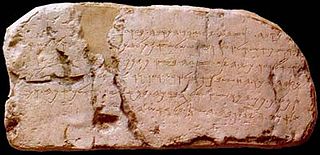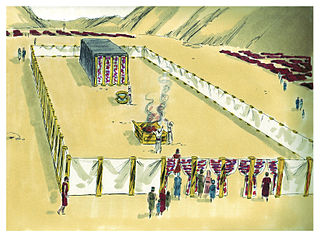Related Research Articles
The Hebrew alphabet, known variously by scholars as the Ktav Ashuri, Jewish script, square script and block script, is traditionally an abjad script used in the writing of the Hebrew language and other Jewish languages, most notably Yiddish, Ladino, Judeo-Arabic, and Judeo-Persian. In modern Hebrew, vowels are increasingly introduced. It is also used informally in Israel to write Levantine Arabic, especially among Druze. It is an offshoot of the Imperial Aramaic alphabet, which flourished during the Achaemenid Empire and which itself derives from the Phoenician alphabet.
Matres lectionis are consonants that are used to indicate a vowel, primarily in the writing of Semitic languages such as Arabic, Hebrew and Syriac. The letters that do this in Hebrew are alephא, heה, vavו and yodי, and in Arabic, the matres lectionis are ʾalifا, wāwو and yāʾي. The 'yod and waw in particular are more often vowels than they are consonants.

Judaism considers some names of God so holy that, once written, they should not be erased: יהוה, אֲדֹנָי (Adonai), אֵל, אֱלֹהִים, אֵל שַׁדַּי, שַׁדַּי, יְהֹוָ֥ה צְבָאֽוֹת and צְבָאֽוֹת ; some also include I Am that I Am. Early authorities considered other Hebrew names mere epithets or descriptions of God, and wrote that they and names in other languages may be written and erased freely. Some moderns advise special care even in these cases, and many Orthodox Jews have adopted the chumras of writing "G-d" instead of "God" in English or saying Ṭēt-Vav instead of Yōd-Hē for the number fifteen or Ṭēt-Zayin instead of Yōd-Vav for the Hebrew number sixteen.
In grammar, a future tense is a verb form that generally marks the event described by the verb as not having happened yet, but expected to happen in the future. An example of a future tense form is the French aimera, meaning "will love", derived from the verb aimer ("love"). The "future" expressed by the future tense usually means the future relative to the moment of speaking, although in contexts where relative tense is used it may mean the future relative to some other point in time under consideration.
Phoenician is an extinct Canaanite Semitic language originally spoken in the region surrounding the cities of Tyre and Sidon. Extensive Tyro-Sidonian trade and commercial dominance led to Phoenician becoming a lingua franca of the maritime Mediterranean during the Iron Age. The Phoenician alphabet spread to Greece during this period, where it became the source of all modern European scripts.
The Moabite language, also known as the Moabite dialect, is an extinct sub-language or dialect of the Canaanite languages, themselves a branch of Northwest Semitic languages, formerly spoken in the region described in the Bible as Moab in the early 1st millennium BC.

Targum Onkelos is the primary Jewish Aramaic targum ("translation") of the Torah, accepted as an authoritative translated text of the Five Books of Moses and thought to have been written in the early second century CE.

Biblical Hebrew, also called Classical Hebrew, is an archaic form of the Hebrew language, a language in the Canaanite branch of Semitic languages spoken by the Israelites in the area known as the Land of Israel, roughly west of the Jordan River and east of the Mediterranean Sea. The term "Hebrew" (ivrit) was not used for the language in the Hebrew Bible, which was referred to as שְֹפַת כְּנַעַן or יְהוּדִית, but the name was used in Ancient Greek and Mishnaic Hebrew texts.

The English modal auxiliary verbs are a subset of the English auxiliary verbs used mostly to express modality (properties such as possibility and obligation). They can most easily be distinguished from other verbs by their defectiveness (they do not have participles or plain forms) and by their lack of the ending ‑(e)s for the third-person singular.

Leviticus 18 deals with a number of sexual activities considered abominable, including incest and bestiality. The chapter also condemns Moloch worship. It is part of the Holiness Code, and its sexual prohibitions are largely paralleled by Leviticus 20, except that chapter 20 has more emphasis on punishment.

The Paleo-Hebrew script, also Palaeo-Hebrew, Proto-Hebrew or Old Hebrew, is the writing system found in inscriptions of Canaanite languages from the region of Southern Canaan, also known as biblical Israel and Judah. It is considered to be the script used to record the original texts of the Hebrew Bible due to its similarity to the Samaritan script, as the Talmud stated that the Hebrew ancient script was still used by the Samaritans. The Talmud described it as the "Libona'a script", translated by some as "Lebanon script". Use of the term "Paleo-Hebrew alphabet" is due to a 1954 suggestion by Solomon Birnbaum, who argued that "[t]o apply the term Phoenician [from Northern Canaan, today's Lebanon] to the script of the Hebrews [from Southern Canaan, today's Israel-Palestine] is hardly suitable". The Paleo-Hebrew and Phoenician alphabets are two slight regional variants of the same script.
Noon is the fourteenth letter of the Semitic abjads, including Phoenician nūn 𐤍, Hebrew nūn נ, Aramaic nūn 𐡍, Syriac nūn ܢ, and Arabic nūn ن. Its numerical value is 50. It is the third letter in Thaana (ނ), pronounced as "noonu". In all languages, it represents the alveolar nasal /n/.
Niphal is the name given to one of the seven major verb stems called בִּנְיָנִים in biblical Hebrew. The designation Niphal comes from the form niph‘al for the verb pa‘al, “to do”. The nun prefix is characteristic of the perfect conjugation, as well as of the participle. In the imperfect conjugation, the nun is assimilated into the first root consonant and appears as a dagesh forte. In the imperative and infinitive construct, the prefix is a he instead of a nun. The infinitive absolute may be prefixed by either the nun or the he.
Northwest Semitic is a division of the Semitic languages comprising the indigenous languages of the Levant. It emerged from Proto-Semitic in the Early Bronze Age. It is first attested in proper names identified as Amorite in the Middle Bronze Age. The oldest coherent texts are in Ugaritic, dating to the Late Bronze Age, which by the time of the Bronze Age collapse are joined by Old Aramaic, and by the Iron Age by Sutean and the Canaanite languages.
In Hebrew, verbs, which take the form of derived stems, are conjugated to reflect their tense and mood, as well as to agree with their subjects in gender, number, and person. Each verb has an inherent voice, though a verb in one voice typically has counterparts in other voices. This article deals mostly with Modern Hebrew, but to some extent, the information shown here applies to Biblical Hebrew as well.
In Jewish religious law, ṭumah and ṭaharah are the state of being ritually "impure" and "pure", respectively. The Hebrew noun ṭum'ah, meaning "impurity", describes a state of ritual impurity. A person or object which contracts ṭumah is said to be ṭamé, and thereby unsuited for certain holy activities and uses until undergoing predefined purification actions that usually include the elapse of a specified time-period.
In Judaism, the Holy Spirit refers to the divine force, quality, and influence of God over the universe or over God's creatures, in given contexts.
The vav-consecutive or waw-consecutive is a grammatical construction in Biblical Hebrew. It involves prefixing a verb form with the letter waw in order to change its tense or aspect.
In linguistics, grammatical mood is a grammatical feature of verbs, used for signaling modality. That is, it is the use of verbal inflections that allow speakers to express their attitude toward what they are saying. The term is also used more broadly to describe the syntactic expression of modality – that is, the use of verb phrases that do not involve inflection of the verb itself.

Paleo-Hebrew Leviticus Scroll, known also as 11QpaleoLev, is an ancient text preserved in one of the Qumran group of caves, and which provides a rare glimpse of the script used formerly by the Israelites in writing Torah scrolls during pre-exilic history. The fragmentary remains of the Torah scroll is written in the Paleo-Hebrew script and was found stashed away in cave no. 11 at Qumran, showing a portion of Leviticus. The scroll is thought to have been penned by the scribe between the late 2nd century BCE to early 1st century BCE, while others place its writing in the 1st century CE.
References
- ↑ "Definition of PARAGOGE". www.merriam-webster.com. Retrieved 2021-01-05.
- 1 2 3 4 5 Robar, Elizabeth (2013). "Nunation". In Geoffrey Khan (ed.). Encyclopedia of Hebrew Language and Linguistics (pre-pub offprint). Leiden: Brill – via Academia.
- ↑ see Leningrand Codex with Morphology, where the paragogic nun is represented by "/Sn". Genesis: 12 occurrences, Exodus: 28, Leviticus: 0, Numbers: 8, Deuteronomy: 58.
- 1 2 Kaufman, Stephen A. 194X- (1995). "Paragogic nun in Biblical Hebrew: Hypercorrection as a Clue to a Lost Scribal Practice". Solving Riddles and Untying Knots: 95.
{{cite journal}}: CS1 maint: numeric names: authors list (link)- "Kaufman, Stephen A, "Paragogic nun in Biblical Hebrew: Hypercorrection as a clue to a Lost Scribal Practice,"..." Balshanut: Resources for the study of the Bible and Linguistics (Review). January 9, 200.
- ↑ W. Randall Carr (2006). Steven Ellis Fassberg, Avi Hurvitz (ed.). The Paragogic nun in Rhetorical Perspective, in Biblical Hebrew in Its Northwest Semitic Setting: Typological and Historical Perspectives. Eisenbrauns. p. 65. ISBN 978-1-57506-116-0.
- ↑ Krahmalkov, Charles R. (2000-11-28). A Phoenician-Punic Grammar. BRILL. p. 183. ISBN 978-90-04-29420-2.
- ↑ Greenspahn, Frederick E. (2003). An Introduction to Aramaic. Society of Biblical Lit. p. 78. ISBN 978-1-58983-059-2.
- ↑ Harris, Zellig Sabbettai (1990). A Grammar of the Phoenician Language. American Oriental Society. p. 40. ISBN 978-0-940490-08-6.
- ↑ Greenspahn, Frederick E. (2003). An Introduction to Aramaic. Society of Biblical Lit. p. 95. ISBN 978-1-58983-059-2.